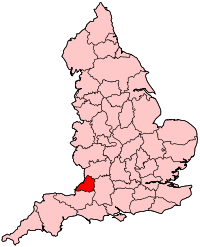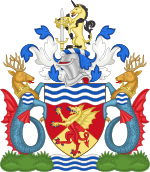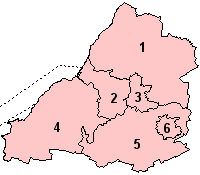Avon (county)
| Avon | |
|---|---|
 Avon shown within England | |
| Area | |
| • 1974 | 332,596 acres (1,345.97 km2)[1] |
| • 1994 | 134,268 hectares (1,342.68 km2)[2] |
| Population | |
| • 1973 | 914,180[3] |
| • 1981 | 900,416 |
| • 1991 | 903,870 |
| History | |
| • Origin | Bristol travel-to-work area |
| • Created | 1974 |
| • Abolished | 1996 |
| • Succeeded by | Bristol South Gloucestershire North Somerset Bath and North East Somerset |
| Status | Non-metropolitan county |
| ONS code | 08 |
| Government | Avon County Council |
| •HQ | Bristol |
 Coat of arms of Avon County Council | |
| Subdivisions | |
| • Type | Non-metropolitan districts |
| • Units | |
 | |
Avon(/ˈeɪvən/) was anon-metropolitanandceremonial countyin thewest of Englandthat existed between 1974 and 1996. The county was named after theRiver Avon,which flows through the area. It was formed from thecounty boroughsofBristolandBath,together with parts of theadministrative countiesofGloucestershireandSomerset.
In 1996, the county was abolished and the area split between four newunitary authorities:Bath and North East Somerset,Bristol,North SomersetandSouth Gloucestershire.The Avon name is still used for some purposes. The area had a population of approximately 1.08 million people in 2009.[4]
Background
[edit]The port of Bristol lies close to the mouth of the River Avon which formed the historic boundary betweenGloucestershireandSomerset.In 1373, a charter constituted the area as the County of the Town of Bristol, although it continued to fall within the jurisdiction of the two counties for some purposes.[5]
The appointment of aboundaries commissionin 1887 led to a campaign for the creation of a county ofGreater Bristol.The commissioners, while recommending that Bristol should be"neither in the county of Gloucester nor of Somerset for any purpose whatsoever",did not extend the city's boundaries.[6]The commission's timidity was attacked by theBristol Mercury and Daily Post,who accused them of using the"crude method of theProcrustean bed".[7]The newspaper went on to attackCharles Ritchie,thePresident of the Local Government Board,and theConservativegovernment:
Everyone who considered the question on its merits was convinced of the justice of the demand for a Greater Bristol, but... the interests of the Tory party were put before every other consideration and we do not think there is any endeavour to conceal the fact.[8]
Under theLocal Government Act 1888Bristol was constituted acounty borough,exercising the powers of both a county and city council. The city was extended to take in some Gloucestershire suburbs in 1898 and 1904.[9]
TheLocal Government Boundary Commissionappointed in 1945 recommended the creation of a "one-tier county" of Bristol based on the existing county borough, but the report was not acted upon.[10]
The next proposals for local government reform in the area were made in 1968, when theRedcliffe-Maud Commissionmade its report. The commission recommended dividing England into unitary areas. One of these was a new Bristol and Bath Area which would have included a wide swathe of countryside surrounding the two cities, extending intoWiltshireand as far asFrome in Somerset.[11]Following a change of government at the1970 general election,a two-tier system of counties and districts was proposed instead of unitary authorities. In a white paper published in 1971, one of these counties, "Area 26" or "Bristol County", was based on the commission's Bristol and Bath area, but lacked the areas ofWiltshire.[12]The proposals were opposed bySomerset County Council,and this led to the setting up of a "Save Our Somerset" campaign.[13]
By the time the Local Government Bill was introduced toParliament,the county had been named "Avon".[14]The boundaries of the new county were cut back during the passage of Local Government Bill through Parliament.[15]TheLocal Government Act 1972receivedRoyal Assenton 26 October 1972.
Creation
[edit]The county came into formal existence on 1 April 1974 when theLocal Government Act 1972came into effect. The new county consisted of the areas of:
- Thecounty boroughsofBristolandBath,
- Part of theAdministrative Countyof Gloucestershire:
- KingswoodUrban District,MangotsfieldUrban District
- Warmley Rural District, most of Sodbury Rural District and most ofThornbury Rural District
- Part of the Administrative County of Somerset:
- Municipal Borough ofWeston-super-Mare
- ClevedonUrban District,KeynshamUrban District,Norton-RadstockUrban District,PortisheadUrban District,
- Bathavon Rural District,Long Ashton Rural District,part ofAxbridge Rural Districtand part ofClutton Rural District.
The county was divided into six districts:
- Bristol and Bath had identical boundaries to the former county boroughs.
- In the north, two districts were created:
- the urban districts of Kingswood and Mangotsfield, and the rural district of Warmley formed a singleDistrict of Kingswood,
- the rest of the areas transferred from Gloucestershire (the rural districts of mostly Sodbury and mostly Thornbury) became the District ofNorthavon.
- In the south, there were two districts:
- on the coast:Woodspring(merger of the municipal borough of Weston-super-Mare, the urban districts of Clevedon and Portishead, and the rural districts of Long Ashton and part of Axbridge),
- and in the interior:Wansdyke(merger of the urban districts of Keynsham and Norton-Radstock, and the rural districts of Bathavon and part of Clutton).
To the north the county borderedGloucestershire,to the eastWiltshireand to the southSomerset.In the west it had a coast on theSevern EstuaryandBristol Channel.
The area of Avon was 520 square miles (1,347 km2) and its population in 1991 was 919,800. Cities and towns in Avon included (in approximate order of population) Bristol, Bath, Weston-super-Mare,Yate,Clevedon, Portishead,Midsomer Norton&Radstock,Bradley Stoke,Nailsea,Yatton,Keynsham,Kingswood,Thornbury,FiltonandPatchway.
Thecoat of armscreated for the county featured six blue and white waves representing the river Avon and parts of the coats of arms of the incorporated areas. The shield featured a dragon from the arms of Somerset divided into gold and red by a chevron from the arms of Gloucestershire.
The crest combined the unicorn of Bristol with the sword ofSt. Paul(one of the patron saints ofBath Abbey) and the crown ofKing Edgar,who was crowned King of England bySt. Dunstanin Bath Abbey.
The sea-stags were created for Avon to represent the historic importance of the Avon ports and theRoyal Forestwhich covered a large part of the County. As aheraldic badge,a sea-stag continued to be used by some organisations in the geographical area.[16][17]
Demise
[edit]
Avon was one of the counties in the "first tranche" of reviews conducted by theBanham Commissionin the 1990s. The Commission recommended that it and its districts be abolished and replaced with fourunitary authorities.The Avon (Structural Change) Order 1995 was debated in theHouse of Commonson 22 February 1995.[18]The Order came into effect on 1 April 1996. The four authorities that replaced Avon are:
- The City and County ofBristol
- South Gloucestershire– formed from theKingswoodandNorthavondistricts.
- North Somerset– formed from theWoodspringdistrict.
- Bath and North East Somerset– formed from theBathandWansdykedistricts.
For ceremonial purposes, the post ofLord Lieutenant of Avonwas abolished and Bristol regained its own Lord Lieutenant andHigh Sheriff,while the other authorities were returned to their traditional counties. Suggestions to alter Bristol's boundaries (either by drawing new boundaries or by merely incorporating the mostly urbanised borough of Kingswood into it) were rejected.
Legacy
[edit]The demise of the County of Avon was the focus of aBBCdocumentary calledThe End of Avon,produced by Linda Orr andMichael Lundand broadcast in 1996. In 2006, theBBC Somersetpresenter Adam Thomas, in aBBC Oneregional programmeInside Out West,investigated why Avon refuses to die. Systems inertia means that the county continues to be included in the databases of large corporations as part of addresses in the area. Some private organisations such as theAvon Wildlife Trustchoose to retain their name. TheRoyal Mailindicated that it is not necessary to include Avon (or any other postal county) as part of any address as it had abandoned their use in 1996.

Some public bodies still cover the area of the former county of Avon: for example,Avon Fire and Rescue Service,the Avon Coroner's District,Avon and Wiltshire Mental Health Partnership NHS Trust,the West of England Strategic Partnership, Intelligence West, and until 2006 the Avon Ambulance Service, when it merged with theGloucestershireandWiltshireambulance services to form theGreat Western Ambulance Service,which subsequently merged withSouth Western Ambulance Service.The former county and its southern neighbour form the area covered byAvon and Somerset Constabulary(governed by theAvon and Somerset Police and Crime Commissioner). Though there is no longer a single council, the four unitary authorities still co-operate on many aspects of policy, such as the JointLocal Transport Plan.[19]Currently, the term "West of England"is used by some organisations to refer to the former Avon area, such as the West of England Local Enterprise Partnership.[20]Avon continued to be used unofficially inboundary reviewsforparliamentary constituencies.[citation needed]
The termCUBA,the "County (or Councils) that Used to Be Avon", was coined to refer to the Avon area after abolition of the county. The termSevernsideis sometimes used as a substitute for "Avon",[21]although the term can also be used to refer to the stretch of shoreline fromAvonmouthnorth toAust,or fromNewporttoChepstow."Greater Bristol"is also used.[22]
TheForest of Avonis acommunity forestcovering part of the area of the four local authorities. Other relics of Avon's existence include the Avon Cycleway (first designed and promoted byCyclebag), an 85-mile (137 km) circular route on quiet roads and cycle paths, which was a precursor of theNational Cycle Network.Also, Avon County Council helped fundSustrans' first cycleway, theBristol and Bath Railway Path.TheAvon Green Belthas continued in place as a jointly agreed policy in thedevelopment plansof the successor local authorities.

In 2016 the government proposed that the four local authorities that replaced Avon come together in aWest of England Combined Authoritywith a "metro mayor"who would oversee a new combined authority, to create a" Western Powerhouse "analogous to the government'sNorthern Powerhouseconcept.[23][24]North Somerset council rejected the proposal but the other three authorities accepted the deal; the combined authority was subsequently established in 2017, with the inauguralmayoral electiontaking place in the May of that year.
As of 2024, a multi-operator unlimited travel daily or weekly bus ticket called AvonRider covering the former county area was still available, supported by local councils.[25]
See also
[edit]- List of Lord Lieutenants of Avon
- List of High Sheriffs of Avon
- List of Sites of Special Scientific Interest in Avon
- List of places in Avon
- Cleveland (county)
- Humberside
References
[edit]- ^Local government in England and Wales: A Guide to the New System.London:HMSO.1974. p. 28.ISBN0-11-750847-0.
- ^Whitaker's Concise Almanack 1995.London: J Whitaker and Sons. 1994. p. 549.ISBN0-85021-247-2.
- ^Registrar General's annual estimated figure mid-1973
- ^"Intelligence West: West of England Key Statistics, Autumn 2010"(PDF).Archived(PDF)from the original on 18 July 2011.Retrieved12 November2010.
- ^Rayfield, Jack (1985).Somerset & Avon.London: Cadogan.ISBN0-947754-09-1.
- ^"The Boundary Commission".Bristol Mercury and Daily Post.27 March 1888. p. 8 – viaBritish Newspaper Archive.
- ^"Greater Bristol".Bristol Mercury and Daily Post.1 June 1888.
- ^"Greater Bristol".Bristol Mail and Daily Post.17 August 1888.
- ^Youngs, Frederic A. Jr. (1979).Guide to the Local Administrative Units of England, Vol. I: Southern England.London: royal Historical Society.ISBN0-901050-67-9.
- ^Report of the Local Government Boundary Commission for the year 1947
- ^Wise, M. J. (December 1969). "Review: The Future of Local Government in England: The Redcliffe-Maud Report".The Geographical Journal.135(4): 583–587.doi:10.2307/1795107.JSTOR1795107.
{{cite journal}}:CS1 maint: date and year (link) - ^HMSO.Local Government in England: Government Proposals for Reorganisation.Cmnd. 4584
- ^"Rural dwellers fight urban takeover".The Times.3 November 1971. p. 5.
- ^"Local Government Bill".Parliamentary Debates (Hansard).16 November 1971.Archivedfrom the original on 11 May 2011.Retrieved18 February2009.
- ^"Somerset loses its battle to remain intact".The Times.17 October 1972.
- ^"CIVIC HERALDRY OF ENGLAND AND WALES-OBSOLETE COUNTIES".civicheraldry.co.uk.Retrieved1 May2023.
- ^"Our History - Girl Guiding Bristol & South Gloucestershire".14 January 2022.Retrieved1 May2023.
- ^"House of Commons Hansard Debates for 22 Feb 1995".Archived fromthe originalon 4 June 2011.Retrieved1 April2010.
- ^B&NES, Bristol, North Somerset & South Gloucestershire Councils, 2005.Greater Bristol Joint Local Transport Plan 2006–2011Archived15 June 2006 at theWayback Machine
- ^West of England Local Enterprise Partnership homepageArchived15 January 2011 at theWayback Machine.Retrieved 7 July 2013
- ^See for example the renaming of the Avon Valuations Tribunal to Severnside, in 1996SI 1996/43Archived5 June 2008 at theWayback Machine
- ^"Study Area".Greater Bristol Strategic Transport Study. Archived fromthe originalon 19 June 2004.
- ^"West of England £1bn devolution deal announced in Budget".BBC News.16 March 2016.Archivedfrom the original on 12 June 2016.Retrieved17 March2016.
- ^Gavin Thompson (16 March 2016)."Metro mayor and £1 billion investment for Greater Bristol announced in Budget 2016".Bristol Post.Retrieved17 March2016.
- ^"AvonRider".travelwest.Archivedfrom the original on 2 September 2018.Retrieved30 June2024.
External links
[edit]- Avon: the name that refuses to die
- West of England LEP: Economic IntelligenceArchived20 March 2019 at theWayback Machine
- Avon Scouts
- Avon architectureAvon architecture, information on key buildings.
- Images of Avonat theEnglish Heritage Archive
